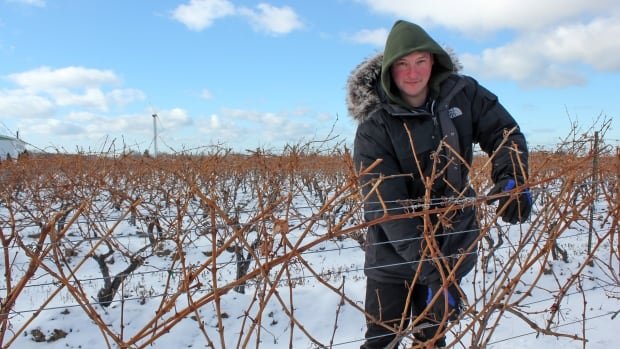An agricultural biotech group based out of the University of Saskatchewan wants to help protect wine grapes from the cold, and that’s welcome news to vineyard owners across the country.
U of S chemist Naveen Diddi has been examining a round glass flask filled with an orange-coloured substance containing abscisic acid — or ABA: a naturally-occurring plant hormone, and says research shows it’s also a key ingredient in keeping wine grape crops alive.
“It’s fluffy,” Diddi said. “It sticks to the glass.”
Diddi is part of a team with ABAzyne BioScience, an agricultural biotech company based at the U of S, that’s using ABA in a solution that can be sprayed on the crops to make them more resistant to frigid winter temperatures.

ABA closes a plant’s stomata — the tiny pore-like structures on its leaves and stem. It helps defend the plant from cold temperatures. ABAzyne’s spray prolongs ABA, which can naturally degrade overtime.
Sue Abrams, chief scientist with ABAzyne, said experiments using the spray on wine grape crops in Ontario show promising results.
“Those grape vines, when sprayed with [our] solution,… were able to be 5 C [to] 6 C more tolerant to freezing temperatures,” said Abrams. “And that’s enough to get them through the winter.”
Climate change impacts grape growing season
The research in Ontario was done by Jim Willwerth at Brock University in St. Catherines, Ont.
Willwerth, an assistant professor of biological sciences who studies grape vines, said the spray not only kept his crop hardier to the cold, but also kept them dormant during periods of warmer weather in the winter.
New Canadian technology is tackling an age-old nuisance on wine grape vines using a combination of ultraviolet light, ozone and hydrogen peroxide to attack mildew and fungus. Experts say this solution uses no toxic chemicals, which is better for the environment and could save growers money.
ABAzyne research shows some varieties of grapes stayed dormant for an additional 16 days during warm spells, once the spray was applied.
“Plants are really responsive to climate,” said Willwerth. “As soon as they start to have weeks of warm weather, it’ll cause them to start to lose that cold tolerance.”
Ben-Min Chang, a research scientist with Agriculture and Agri-Food Canada in Summerland, B.C., said warm weather in winter triggers the plants to wake up from dormancy.

He said temperature extremes driven by climate change in B.C. this winter were detrimental to wine grape crops.
“We had … a super warm winter and suddenly [a] cold snap [came],” said Chang. “For grape vines, there’s no time for them to get used to that sudden change.”
A report from B.C.’s wine industry showed a nearly 100 per cent decrease in grape and wine production as a result of -25 C to 30 C temperatures in January.
The B.C. wine industry is facing catastrophic wine grape crop losses this year. As Brady Strachan reports, a prolonged cold snap in January has damaged vineyards across the Okanagan.
Spray could benefit commercial wineries
ABAzyne’s research is being supported by Ontario Grape and Wine Research Inc. (OGWRI).
OGWRI chair Matthias Oppenlaender said he’s encouraged by what the research could mean for his province’s industry and for his own winery, Huebel Grape Estates, near Niagara-on-the-Lake, Ont.
Huebel has suffered major crop loss over the years due to cold weather. Oppenlaender says it’s especially difficult when cold weather not only kills buds on his vines, but entire vines themselves.
“If you lose your vineyard, it can cost up to $50,000 to $60,000 an acre to replant,” he said. “Not only that, it takes three to four years to bring [a] plant into production again.”
The spray is also of interest to Dean Kreutzer, owner of Over the Hill Orchards and Winery near Lumsden, Sask., not only because the Prairies face brutal winter cold snaps, but also because research shows the spray can protect grape crops from frost.

“If we get a late frost, say in early June … and the vines are growing, that could definitely help,” said Kreutzer. “The grapes are like tomatoes. If you get -1 C on them, anything green on a grape will die.”
Kreutzer says other solutions may be possible. He’s currently breeding higher quality grapes with hardier, lower quality grapes found in southeastern Saskatchewan to come up with a grape that is both rich in flavour, but can withstand Prairie winters.
Spray more effectively produced at U of S facility: researchers
ABAzyne BioScience’s Sue Abrams says while other research institutions have worked with ABA, the company’s U of S facility is pioneering technology to mass produce its solution.
Diddi says he’s created a quicker way to perform chemical reactions — or synthesis.
“The process is now a two-step synthesis,” said Diddi. “Now we can synthesize the product in multi-hundred gram quantities. This process is scalable, very efficient and cheap.”

Abrams said the product likely won’t be marketed commercially for another couple of years. Part of that time is spent getting approval from the Canadian Food Inspection Agency.
She says the product is safe to consume and is sprayed on vines after fall harvest, leaving only trace amounts on grapes come spring.
Since ABA also helps plants conserve water, research is underway on other plants — like tomatoes — to see if the spray could be used to protect them from drought stress.
“We see real big opportunities for these [ABA] molecules to have a big impact on agriculture, if we can make them cheaply enough,” said Abrams.












